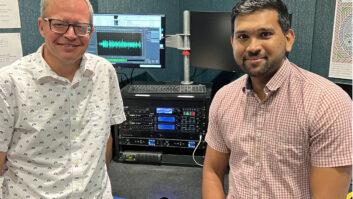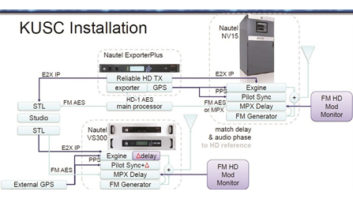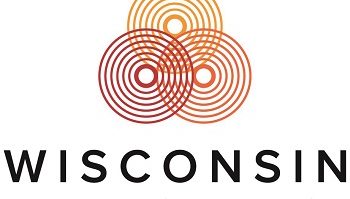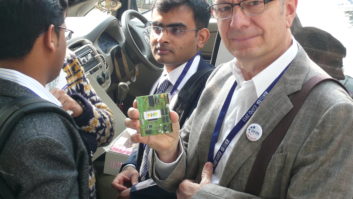HD Radio for a statewide network
Nov 1, 2006 12:00 PM, By Chriss Scherer, editor
Every HD Radio installation is different because of the unique characteristics of the transmitter site, including the tower, the antenna and the available transmitter building space. As stations consider their options to install HD Radio equipment, it’s not uncommon to change the design plan as additional information is discovered. In many cases, a station can examine another HD Radio operation and borrow ideas to apply to its own circumstances. For Wisconsin Public Radio (WPR), this was not quite the case.
Radio magazine has covered several HD Radio installations at commercial broadcast stations, so it was time to look at noncommercial side of radio to see how one radio network was making the change to HD Radio.

Looking through the WERN antenna
Wisconsin Public Radio has 27 radio stations in its statewide network. These stations carry one of two programming networks: NPR News and Classical Music (on 13 stations) or the primarily talk-formatted Ideas Network (on 14 stations). The public broadcaster is also developing a third programming network of all-classical music, which will be used to feed the HD2 channels of the network’s HD Radio installations.
The network’s goal is to convert all its stations for HD Radio. The current timeline accounts for all but two of the stations to be converted to HD Radio by August 2008, although the remaining two may be completed by that date as well. The network is currently converting WLSU in La Crosse, WHAD in Delafield and WPNE in Green Bay.
Late last year, two stations were converted to HD Radio: WERN, Madison, and WHRM, Wausau. These stations, licensed to the Educational Communications Board of Wisconsin, began the process of installing HD Radio equipment in the first quarter of 2004. The process began with applying for grants through the Corporation for Public Broadcasting. The grants were approved during the summer of 2005, and the work began shortly thereafter.
At KUWS-FM in Superior and WHA-AM in Madison, both licensed to the University of Wisconsin, converted to HD Radio.
The stations
The two stations have different antenna systems. WHRM uses a multistation, 10-bay ERI panel antenna that was designed to accept HD Radio signals on the second input. This community antenna installation has been adding HD Radio stations since it was installed in early 2004.

The test equipment setup that was used to sweep the antenna.
The antenna for WERN, a Jampro JAPD, was installed for the station’s analog signal before HD Radio was being considered. Adding another antenna to the tower was not possible, so a separate antenna approach was not considered. Because the existing analog antenna had the power capability, the original plan was to install an HD Radio transmitter and high-level combine the analog and digital signals to feed the antenna. While awaiting the grant approvals, WERN Technical Services Manager Peter Ives continued to investigate HD Radio technology, and during the 2004 Broadcasters’ Clinic in Madison, WI, he learned that Jampro was developing a retrofit upgrade for the JAPD to accept a second input.
The antenna-combined method appealed to Ives because it would require less room in the transmitter building and result is less wasted energy because of the high-level combiner. The alternate plan, however, meant that he would need to run an additional length of 15/8� coax to the antenna. The tower owner had concerns about the added wind loading, but this was addressed by routing the new coax within an existing cable bundle. The resulting added wind resistance had a minimal effect on the tower. Ives modified his installation plan and began the work to modify the WERN antenna and install the additional transmission line. The WERN project included installing a combiner section on the tower near the antenna and replacing the feeder assembly to the antenna bays.
The radio upgrade for WERN and WHRM occurred at the same time as the construction of the Wisconsin Public TV/WPR digital Operations Center in Madison. The Operations Center delivers 12 TV networks to a dozen Wisconsin TV transmitters, six translators, two affiliates, numerous cable networks, Direct TV and educational content to schools. The ops center also distributes Wisconsin Public Radio networks program content and data to 27 stations.
The tower work on WERN began at the beginning of the summer of 2005, and the two radio stations completed their upgrades in August and September 2005. In October 2005, Jampro performed the final tuning of the installed system.
New transmitters were also installed as part of the upgrade. WERN installed a Broadcast Electronics FMI 73, and WHRM installed a Broadcast Electronics FMI 106. The digital transmitters were installed next to the existing analog transmitters.
The two stations are not yet transmitting a multicast signal, but there are plans to implement multicast in the coming months.
Broadcast Profile
Wisconsin Public Radio
- 27 radio stations
25 FM, 2 AM - 7 bureau locations
Milwaukee, Madison, Green Bay, La Crosse, Eau Claire, Superior, Wausau - 2 programming formats
- 4 stations on the air in HD Radio
KUWS-FM, WERN-FM, WHA-AM, WHRM-FM
Interconnected facilities
WERN and WHRM did not need to install new STL equipment for the upgrades because the stations within the Wisconsin Public Radio network are connected through an ATM network. The ATM network connects seven nodes around the state through DS3 circuits. These nodes are broadcasting bureaus, transmitter sites or the WPR headquarters. Transmitter sites that are not located at one of these nodes are connected to the network via T1 circuits and Intraplex or Moseley interface equipment. WHRM is one of these stations.
One of the goals of WPR is to provide a completely digital path to each transmitter whenever possible. For WHRM, this required an upgrade to its Intraplex system to connect the site to the bureau in Wausau, WI. Enhanced Apt-x cards were added to its system for additional capacity and to maintain a completely digital path.
All but two sites are connected via the ATM or T1 links. These remaining two sites rely on 950MHz STL links.
Unique challenges
Operating a state-wide network provides some challenges that most radio stations � particularly commercial stations � do not encounter. In most HD Radio installations, one studio facility feeds one transmitter site. In the case of WPR, several locations can feed several transmitter sites, so each transmitter site must be capable of remotely switching between multiple audio feeds, such as EAS, station ID, local underwriting, feeds from any of the state-wide bureaus and the programming network.
Commercially available programmable logic controllers are used to control a digital audio switcher. Some events are controlled by timer, others by RS-232 or Ethernet.
Overall, WPR and Peter Ives are pleased with the installations. Ives notes that there were some small changes to the WERN coverage after the antenna modifications were completed, but the differences are minor. The cause of the changes will be investigated later.












